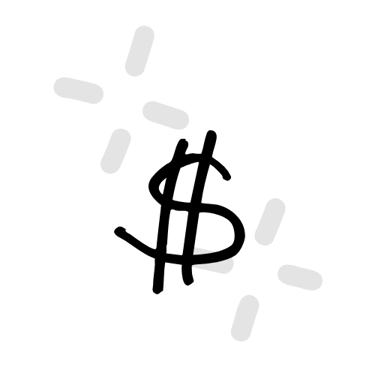What is a Product Pricing Calculator?
Struggling to decide how much to charge for your products?
Our Product Pricing Calculator takes the guesswork out of pricing. In just a few clicks, you can calculate your unit cost, breakeven price, and recommended selling price based on your fixed costs, variable costs, sales volume, and profit margin.
This calculator combines two important steps in pricing: first, building a list of fixed and variable costs for your product or service, and second, calculating your breakeven price, recommended selling price, and expected profit.
By letting you input specific costs like rent, salaries, packaging, and raw materials, it gives a clear picture of what it really takes to run your business and how to set prices that ensure profitability.
*If you have Already calculated your Fixed cost and Variable cost, you can skip "Build your cost table" and go straight to calculating the pricing.
What Costs Should You Consider?
When building your product pricing, it’s essential to account for both fixed and variable costs. Forgetting even small expenses can distort your breakeven point and profit calculations. Here’s a guide:
Fixed Costs (stay the same regardless of sales volume)
These are expenses your business pays regularly, even if you don’t sell a single unit.
Rent or mortgage
Salaries and wages (for permanent staff)
Insurance (business, liability, health, etc.)
Utilities (electricity, water, internet)
Equipment leases or depreciation
Software subscriptions and licenses
Marketing/advertising retainers
💡 Tip: Think of fixed costs as the “baseline” bills you must pay to keep the business running.
Variable Costs (change with production or sales volume)
These costs increase or decrease depending on how many units you sell or produce.
Raw materials (ingredients, components, supplies)
Packaging (boxes, labels, wrapping, bags)
Shipping and delivery costs
Transaction fees (payment processor, platform commissions)
Hourly wages (if tied to production volume)
Sales commissions
💡 Tip: If the cost goes up every time you sell one more unit, it’s variable.
How to Use the Pricing Calculator (Step-by-Step)
*If you have Already calculated your Fixed cost and Variable cost, you can skip the "Build your cost table" and go straight to calculating the pricing.
Enter your fixed costs (e.g., rent, equipment, utilities)
Enter your variable cost per unit (e.g., materials, packaging).
Add more rows if needed for additional costs.
Enter your expected sales volume (number of units you expect to sell).
Enter your desired profit margin (in %).
Click “Calculate” to see results instantly.
The result will indicate:
- Breakeven Price: The minimum selling price needed to avoid a loss.
- Breakeven Revenue: The Total Revenue if you only sold the minimum products (breakeven unit) at your profit margin
- Recommended Price: The selling price you should charge to achieve your desired profit margin.
-Expected Profit: Profit you will make at your desired profit margin.


Why Use a Product Pricing Calculator?
Getting your pricing strategy right is critical for business success. Set prices too low, and you’ll lose profits; too high, and you may lose customers.
The Simple Product Pricing Calculator helps you find the balance by showing your true costs, breakeven point, and profit-driven recommended price.
The Product Pricing Calculator is especially helpful when:
Launching a new product and unsure how to price it
Reviewing existing prices to improve profitability
Calculating the breakeven point before investing in production
Comparing multiple products or business models for profit potential
Avoid underpricing by overlooking hidden costs.
What is a Good Price vs. a Bad Price?
A “good” price isn’t just about being cheaper than competitors.
It’s a balance between covering your costs, achieving your target profit margin, and matching what customers are willing to pay.
✅ Good Pricing:
Covers all costs, provides a reasonable profit margin (20–50% in many retail businesses), and is competitive in your market.
⚠️ Bad Pricing:
Either too low (causing you to lose money or undervalue your product) or too high (causing customers to buy from competitors).
Pricing should be evaluated in context — a high profit margin looks attractive, but if it makes your product unaffordable to your target audience, it can hurt sales.
Product Pricing is calculated using the formula:
Breakeven Price
Breakeven Price = (Fixed Costs / Sales Volume) + Variable Cost per Unit
👉 This tells you how much it costs to produce one unit, including both fixed and variable costs.
It's also the minimum price you must charge per unit to avoid losing money.
Breakeven Revenue
Breakeven Revenue = Breakeven Units × Recommended Price
👉 Total Revenue if you only sold the minimum products at your profit margin
Recommended Price
Recommended Price = Unit Cost / (1 − Desired Profit Margin)
👉 This is the selling price that covers all costs and adds your target profit margin.
Expected Profit:
Expected Profit = (Recommended Price – Variable Cost) × Sales Volume – Fixed Costs
👉 Profits if you When all units are sold at profit margin
Use Case: Small Business
Imagine you run a small candle business. Your fixed costs, such as rent, insurance, and subscriptions, total $2,000 per month.
Each candle has variable costs that increase with production: raw materials (wax, wicks, jars) $3.00, packaging $1.00, shipping $2.00, and transaction fees $0.50, totaling $6.50 per candle.
You expect to sell 500 candles per month and want a 30% profit margin.
Here’s how the calculator works it out:
Breakeven Price
(Fixed Costs ÷ Expected Sales Volume) + Total Variable Cost
= ($2,000 ÷ 500) + $6.50 = $4.00 + $6.50 = $10.50Recommended Price
Breakeven Price ÷ (1 − Profit Margin) = $10.50 ÷ (1 − 0.30)
= $10.50 ÷ 0.70 = $15.00
Contribution Margin per Unit
Recommended Price − Variable Cost
= $15.00 − $6.50 = $8.50
Breakeven Units
Fixed Costs ÷ Contribution Margin per Unit
= $2,000 ÷ $8.50 ≈ 236 candlesBreakeven Revenue
Breakeven Units × Recommended Price
= 236 × $15.00 = $3,540Expected Profit
(Recommended Price − Variable Cost) × Expected Sales Volume − Fixed Costs
= ($15.00 − $6.50) × 500 − $2,000 = 8.50 × 500 − 2,000 = $2,250
👉 This shows that if you sell each candle at $15, you’ll cover all costs and achieve your 30% profit margin, and selling more increases your total profit.
Tips for Better Pricing
Research Your Market
Check competitor pricing to see where your product fits. If you’re higher priced, highlight quality or uniqueness; if you’re lower priced, make sure you’re not sacrificing too much profit.
Understand Customer Perception
Customers don’t just buy based on cost — they also buy based on perceived value. A higher price can sometimes make your product look more premium.
Test and Adjust
Don’t be afraid to experiment. Start with a calculated price, then adjust based on customer response and sales performance.
Use Psychological Pricing
Small tweaks like pricing at $19.99 instead of $20 can influence buyer decisions without significantly affecting your margin.
Think About Long-Term ROI
Sometimes a lower margin at the start (introductory pricing) can help attract customers and build loyalty, which pays off in the long run.
Consider Different Strategies
Depending on your goals, you might use:
Cost-plus pricing (cover costs + margin)
Value-based pricing (based on customer perceived value)
Competitive pricing (aligning with the market rate)
Common Challenges When Pricing Products
While the calculator makes pricing easier, beginners may still face some challenges:
1. Inaccurate Inputs (Forgetting Expenses, Hidden Costs)
Many businesses overlook additional expenses like shipping, packaging, marketing, or transaction fees. Missing these costs can lead to underpricing and reduced profitability.
Tip: Always include all expenses related to the investment, not just the obvious ones.
2. Overestimating Sales Volume
Assuming you’ll sell more units than realistic can lead to underpricing.
Tip: Be conservative with sales estimates.
3. Not Adjusting for Changes Over Time
Costs, competition, and customer preferences change. A price that works today may become unprofitable in the future if not updated regularly.
Tip: Regularly review and update your prices to keep them profitable and competitive.
4. Setting Prices Without Market Research
Even if your calculated price covers costs, customers may not be willing to pay it. Pricing must consider perceived value and what the market will bear.
Tip: Set prices based on both costs and what customers are willing to pay.
In short:
Product Pricing Calculator is a great tool to set profitable prices, helping you cover costs and target a desired margin, while also considering market demand, competition, and changing expenses.
View our blogs Below






Business Calculator
View Our handy business calculators! While we make more...

